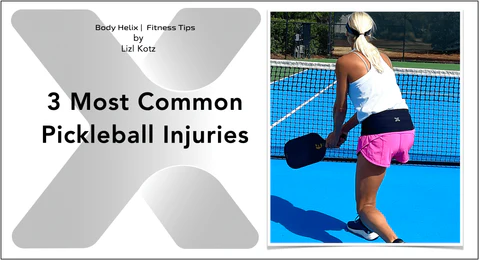“You can’t get hurt during pickleball, can you?”
Of course you can! While its popularity in recreation has risen due to the slower, lower-intensity nature, any regular pickleball player knows it can get challenging in the heat of the moment. According to the USA Pickleball Association, pretty much every joint from shoulder down can be injured while playing, and the best way to avoid this is a good warm-up. If these common injuries do happen while playing pickleball, what do you do about it?
The 4 most common injuries in pickleball
1. Achilles Strain/Ankle Sprain
Achilles strains involve the tendon at the back of your ankle connecting the calf to your heel. Most commonly, strains of the Achilles’ tendon result from a sudden stop-and-go and are accompanied by a sharp snapping feeling.
Ankle sprains, on the other hand, are injuries to the ligaments on the side of the ankle. Usually, these are caused by missteps or faulty landings and can vary in severity. Lateral ankle sprains are the most common, but they can also occur medially or as high ankle sprains.
With the constant change of direction in pickleball, it’s no surprise that ankle injuries prevail. Bracing can prove a strong preventive and rehabilitative measure for lower-grade injuries, while others require complete rest.
"This stabilized my rolled/sprained ankle and has allowed
me to continue playing pickleball."
-Art, Body Helix customer
2. Hamstring, groin, or quad strain
In pickleball, muscle strains typically come from overreaching to save a ball or return a shot. Depending on your positioning, you can injure any muscle of the leg if not properly prepared.
When too much is asked of a muscle before it’s warm or flexible enough to perform a certain movement, you’ll get a strain. In order to prevent muscular strain, a proper warm-up and regular strength and mobility program is advised.
3. Wrist Tendinitis/Fracture
While injury can occur in any sport, wrist tendinitis is characteristic of racquet sports. Pickleball players are manipulating a paddle rapidly back and forth to serve, return, lob, and backhand balls. Tiny tears can cause instability, pain, and repetitive trauma that compromises the wrist. These can occur in any tendon, but often strike the flexor carpi ulnaris, extensor carpi ulnaris, and flexor carpi radialis.
An intense game of pickleball means someone might fall in an attempt to rescue a shot. Our natural instinct is to put our hands down to catch ourselves, and that’s when wrist fractures happen. A perfect storm of conditions leads to a distal radial fracture, the easiest way to break your wrist when bracing for a fall. If you come up with a wrist fracture from pickleball, a doctor might put you in a brace or cast to give it time to heal.
4. Shoulder impingement
Tendons in your rotator cuff can get squished together with powerful, overhead movements. A general term for this irritation is shoulder impingement. Other problems that can strike the rotator cuff tendinitis, bursitis, and even a tear, which can all result from pickleball. Older players with limited shoulder mobility are especially susceptible to shoulder impingement.
Common Shoulder Injuries and How to Get Relief
Treatment

In all of these conditions, early recognition and treatment are paramount to returning to pain-free play. Ice and bracing can assist tendonitis/bursitis, while fractures need time without movement to fully heal. It’s best to ask your doctor about any injury, in case it’s worse (or better) than you expect.
When returning to play, take care to follow a specific rehab program given by your physical therapist. Many minor injuries to muscle or connective tissue can be managed with rehab, ice, compression, and NSAIDs, so you may not have to take too much time away from the game. All of these combine to help your body adjust to movement while keeping the negative aspects at bay. Movement heals, so when it’s safe to get back out there, do so. But take it slow and take necessary precaution to avoid re-injuring the area.






